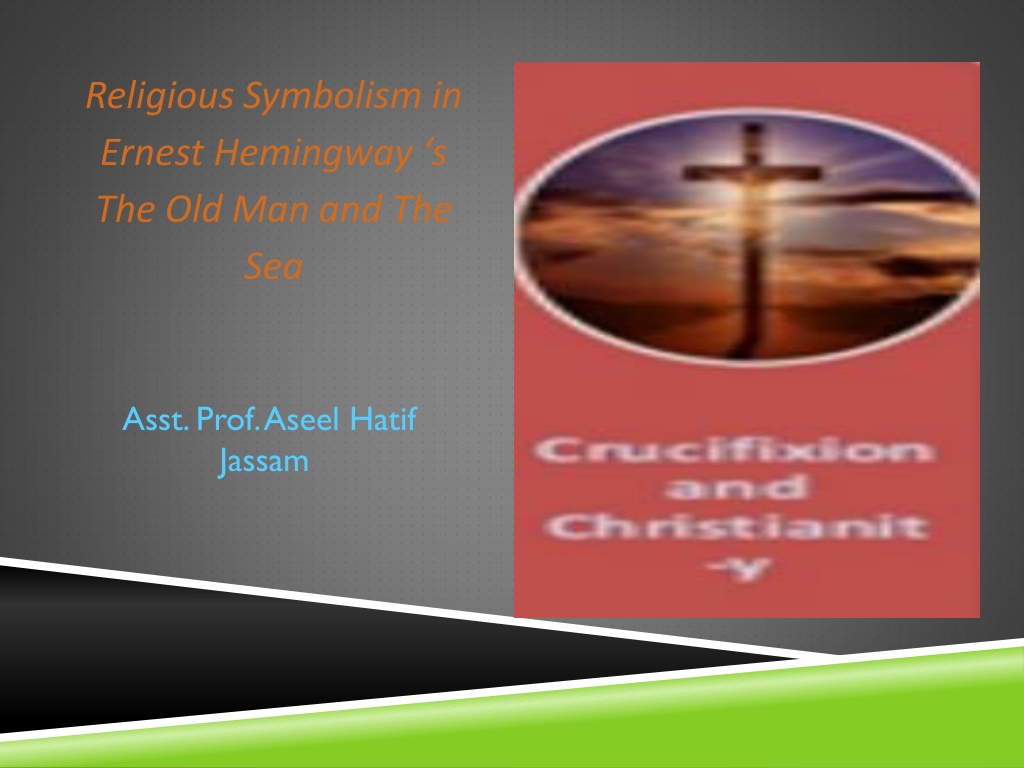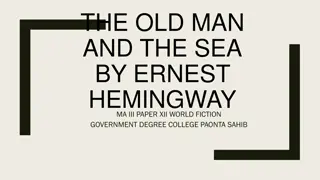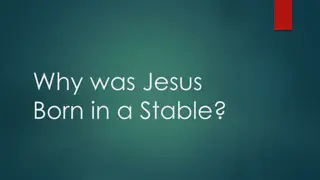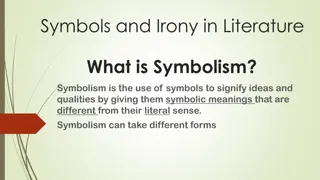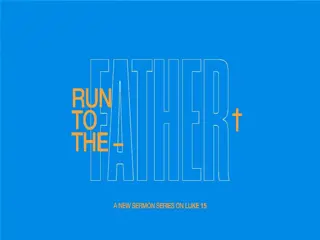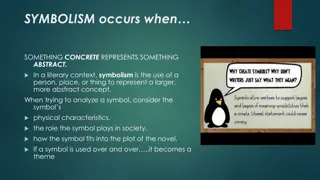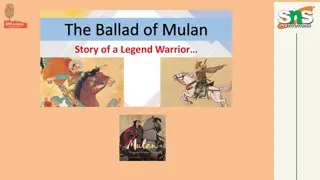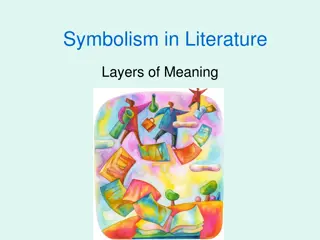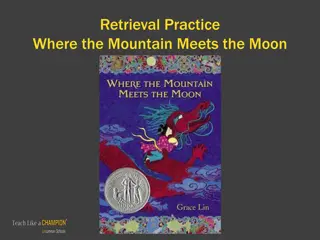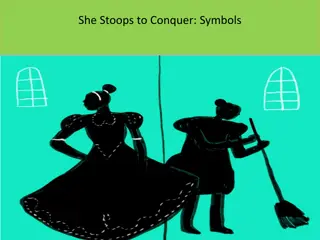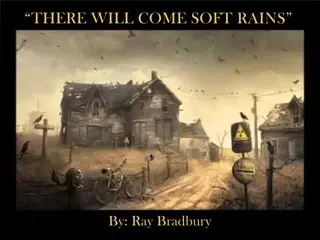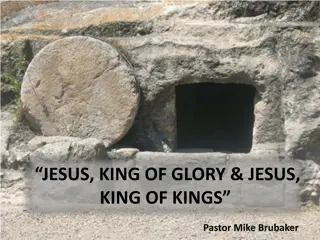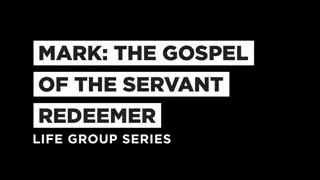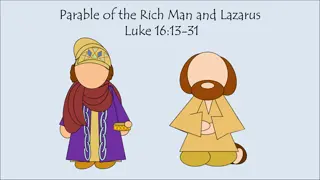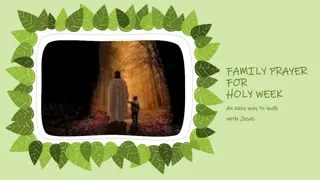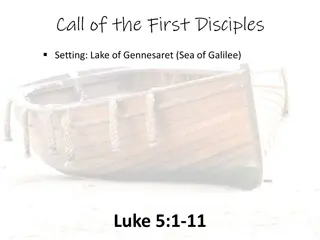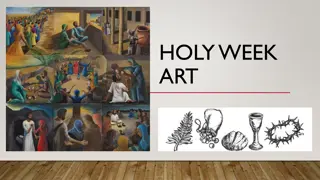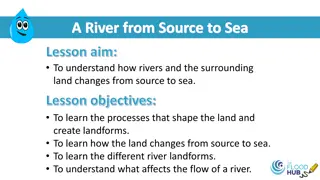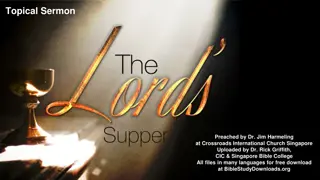Symbolism of Jesus in Hemingway's The Old Man and The Sea
Stories by Ernest Hemingway often contain religious symbolism, and The Old Man and the Sea is no exception. The protagonist, Santiago, mirrors the life of Jesus, with parallels in character names, actions, and outcomes. Through characters like Manolin representing the Messiah and Pedrico symbolizing Saint Peter, the narrative weaves a tapestry of biblical references, such as Santiago's crucifixion-like experience with the marlin. The story culminates in a portrayal of Santiago's trials and triumphs akin to the life and resurrection of Jesus, showcasing Hemingway's deliberate construction around religious themes.
Download Presentation

Please find below an Image/Link to download the presentation.
The content on the website is provided AS IS for your information and personal use only. It may not be sold, licensed, or shared on other websites without obtaining consent from the author. Download presentation by click this link. If you encounter any issues during the download, it is possible that the publisher has removed the file from their server.
E N D
Presentation Transcript
Religious Symbolism in Ernest Hemingway s The Old Man and The Sea Asst. Prof. Aseel Hatif Jassam
RELIGIOUS SYMBOLISM IN ERNEST HEMINGWAY S THE OLD MAN AND THE SEA Many times, stories by Ernest Hemingway have much religious influence and symbolism. In The Old Man and the Sea, numerous occurrences in the life of Santiago the fisherman are similar to the incidents recorded in the life of Jesus of Nazareth. The names of the characters translated from Spanish to English are just examples of those many similarities. The characters in The Old Man and the Sea are in actuality, major figures in the New Testament. Santiago is an old man, yet he has young eyes. No matter how defeated he is, he will never show it and he will look on the brighter side of things. These traits make Santiago a god-like figure. Manolin, which translates into Messiah, is Jesus (Stoltzfus qtd in CLC 13:280). Santiago is the "father" who teaches his symbolic son and disciple, Manolin. After catching the largest marlin, Manolin will leave his parents in order to follow the teachings of Santiago, his master, just as Jesus did (Stoltzfus qtd in CLC 13:280).
Pedrico is actually Saint Peter, Jesus' closest apostle and a great fisherman (Wilson 50). Peter helped Jesus fish for souls as Pedrico helps Manolin fish for food. Santiago gives Pedrico the head of the mutilated marlin which symbolizes Saint Peter as head of the Christian church and the first Pope (Stoltzfus CLC 280) In the story, there are many references to the crucifixion of Jesus. Santiago's badly injured hands evoke the hands of the crucified Jesus and three other situations reinforce this theory. First, Santiago's marlin is approached by a pair of shovel nosed sharks. "Ay', he said out loud." (Hemingway, The Old Man and the Sea) There is no meaning of "Ay", but perhaps it is the sound a man makes as his hands are nailed to wood (Brenner, The Old Man and the Sea, Story of a Common Man )
Next, once back on shore, Santiago climbs the hill to his shack, with the mast on his shoulder, falling several times (Hemingway, The Old Man and the Sea 121). This is an obvious reference to Christ's struggle to carry the cross up the hill Cavalry (Crossan, The Historical Jesus 163). Finally, Santiago has hooked a fish. It is a Friday, symbolic of Good Friday, the day Jesus was crucified. The hook goes into and through the mouth of the fish, just as the nail went through the hand of Jesus. On the second day, the old man anxiously awaited the rising of the fish to the top of the water.
Santiago says ten Hail Marys and ten Our Fathers. On the second day after the death of Jesus, his followers awaited his resurrection and prayed. On the third day, the fish rose and the old man has killed it. This day refers to Easter Sunday when Jesus rose from the dead, and then ascended to heaven. Therefore, the incidents that occurred in the life of Santiago are very similar to the occurrences in the life of Jesus of Nazareth. Ernest Hemingway decides to construct his story to reflect upon the life of Jesus but does not make this too obvious to the reader. There are many references to the crucifixion of Jesus. This shows that the old man and Jesus suffered in many of the same ways. They were both fishermen. The old man is the fisherman of fish and Jesus was the fisherman of souls.
BIBLICAL NUMEROLOGY The old man stats fishing with the boy for forty days and then he alone fishes for forty-four days, struggling with the marline for three days, and landing it on the seventh attempt,killing sharks and resting seven times. Santiago s return in three days from the death-like sea parallels resurrection.The religious symbols employed by Hemingway are biblical echoes voicing the author s faith and acting as symbolic devices. The Christological elements like love, forgiveness, and compassion can be seen in the marline and Santiago locked in a moral combat. The number 3 is a symbol of divine perfection.It is also the numerical signature of God.As well as the representing personal completeness, it is the number of the Godhead, and stands for Trinity.
THE SYMBOLIC SIGNIFICANCE OF BASEBALL Ernest Hemingway's The Old Man and the Sea takes place in and around Cuba. The love of baseball began to grow in Cuba during the late 1800s, and by the time of the action in The Old Man and the Sea, baseball had become a national sport and pastime, much like, say, hockey in Canada or soccer (football) in Brazil. So an old Cuban fisherman who talks about baseball is realistic in Hemingway's setting. Santiago's continual references to Joe DiMaggio, though, go much further than just establishing a realistic setting. To Santiago, Joe DiMaggio who was and still is considered the greatest baseball player in history represents what a man should be. Santiago idolizes DiMaggio in part because he (DiMaggio) suffered through the pain of a bone spur to make a great comeback.
This idea of struggling and persevering in order to ultimately redeem one's individual existence through one's life's work is central to the conflict of The Old Man and the Sea. As Santiago struggles with the marlin, he equates his struggle with the pain of DiMaggio's bone spur and tries to live up to DiMaggio's example by not giving up on the marlin. Ernest Hemingway's use of baseball and mention of Joe DiMaggio in ''The Old Man and the Sea'' come to represent an ideal to the fisherman Santiago, one that he continues to compare himself against to measure his success and worth.
In Cuba, the setting of Hemingway's novel The Old Man and the Sea, the game of baseball is a national sport and pastime. It holds a special place in everyone's heart. Santiago also discusses baseball with himself. It is a way for him to stay focused and not become delusional. When he is on the sea holding onto the big fish he has hooked, he recognizes that he is ''tired inside.'' Santiago realizes that all he has left to think about is the fish. ''That and baseball.'' These thoughts help him stay determined and focused despite his exhaustion
